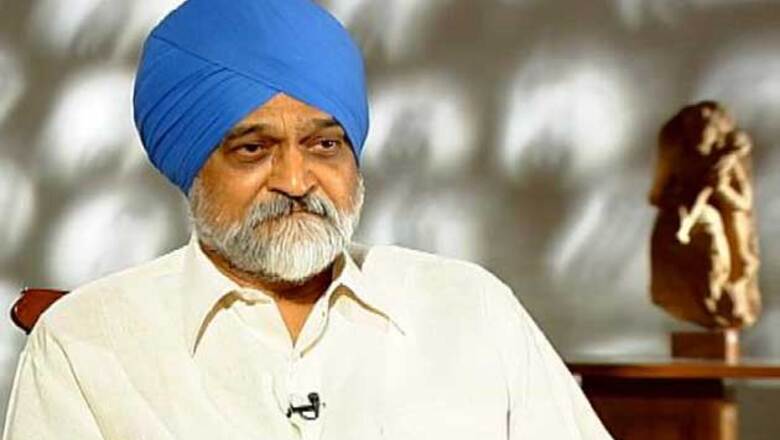
views
New Delhi: If this year's preparations on India's next Five-Year Plan (2012-17) provide any indication, the Planning Commission is likely to set ambitious targets for economic growth and infrastructure development for the period.
Clouded by the global economic meltdown that began in 2008, the current Plan (2007-12) needed a lot of scaling down of the targets and the mid-term review was quite straight about it.
Against this backdrop, the Plan panel kicked off the process of formulating the 12th Five-Year Plan, which may eventually see the official think-tank pegging the annual growth rate at 10 per cent, up from 8.1 per cent in the current Plan.
The Planning Commission started the process of preparing the Approach Paper in the second quarter this fiscal and it is expected to be ready by March, 2011.
It is the key document on the basis of which the detailed Five-Year Plan is worked out. The 12th Plan will commence on April 1, 2012.
Unlike earlier years, this time the panel is seeking inputs from individuals as well - besides heavy-weight stakeholders - to make the process of Plan formulation more inclusive, for which it has set up a special website.
Before launching the preparatory work for the next Plan, the Commission came out in March with a Mid-Term Appraisal (MTA) of the 11th Plan.
The review took note of the impact of the global financial meltdown on the Indian economy and also the projections for growth. It scaled down the growth estimate from 9 per cent to 8.1 per cent.
The review was considered and approved by the National Development Council (NDC) - the highest policy making body in the country, headed by the Prime Minister and comprising key Union ministers and state chief ministers.
"The average rate of growth in the Plan period could be a little over 8 per cent (8.1 per cent). This would be below the original plan target of an average of 9 per cent growth. But it would be better than the 7.8 per cent achieved in the Tenth Plan period," the Commission said in the MTA.
It said the economy will expand by 8.5 per cent in 2010-11 and rise to 9 per cent in the terminal year of the 11th Plan.
It had set an average annual growth target of 9 per cent for the 11th Plan - beginning with 8.5 per cent in the first year and closing with 10 per cent in 2011-12.
The MTA document said the economy exceeded expectations in 2007-08, with a growth rate of 9 per cent, but the momentum was interrupted in 2008-09 because of the global financial crisis.
Following the global meltdown, the growth rate slipped to 6.7 per cent in 2008-09 from over 9 per cent in the receding three years.
For the following year, the growth rate was pegged at 7.2 per cent, despite the poor contribution from the farm sector, which was projected to shrink by 0.2 per cent, the MTA said.
However, according to government data released later in May, the economy grew by 7.4 per cent in 2009-10.
Buoyed by the recovery since the last meeting of the full Planning Commission in September 1, 2009, the document said, "The economy would be well-positioned for transition to a growth rate higher than 9 per cent in the Twelfth Plan period."
For achieving a high growth rate, the Commission suggested that the government focus on fiscal consolidation and maintaining an investor-supportive economic environment.
Finance Minister Pranab Mukherjee, too, had said in his Budget speech, "The first challenge before us is to quickly revert to the high GDP growth path of 9 per cent and then find the means to cross the double-digit growth barrier."
The other important indication given by the Commission is its thrust on infrastructure development in the 12th Plan.
The Commission, on many occasions, categorically pointed out that double-digit economic growth can only be achieved when investment in infrastructure is doubled.
It reiterated Prime Minister Manmohan Singh's stress on the need to double investments in the infrastructure sector during the 12 Plan to $1 trillion from $500 billion in the current Five-Year Plan.
"Preliminary exercises suggest that investment in infrastructure will have to expand to $1,000 billion in the 12th Five-Year Plan. I urged the Finance Ministry and the Planning Commission to draw a plan of action for achieving this level of investment," Singh said in March this year.
In a foreword to a report on investment in infrastructure, Planning Commission Deputy Chairman Montek Singh Ahluwalia also said the country needs an investment of over $1 trillion in the infrastructure sector during the next Five-Year Plan.
"A preliminary assessment suggests that investment in infrastructure during the 12th Plan would need to be of the order of about Rs 40.99 lakh crore ($1,025 billion) to achieve a share of 9.95 per cent as a proportion of the GDP,"
Ahluwalia said.
The year gone by also left some stains on the Commission.
Addressing an infrastructure summit organised by the panel in July, Road Transport and Highways Minister Kamal Nath termed the Planning Commission an "armchair advisor", oblivious to the ground realities.
That apart, in August, Left-leaning students of Presidency College hurled eggs and tomatoes at Ahluwalia to protest against price rise as he was leaving a seminar, but missed their target. His wife, Isher Judge Ahluwalia, was also
present at the seminar.
"They are students and they have every right to protest," Ahluwalia said after the incident




















Comments
0 comment